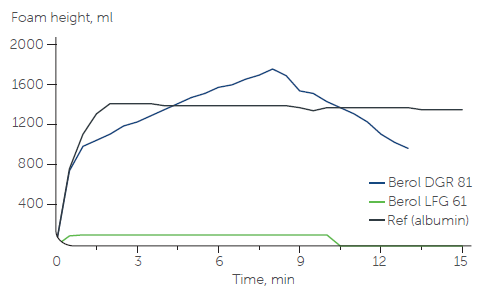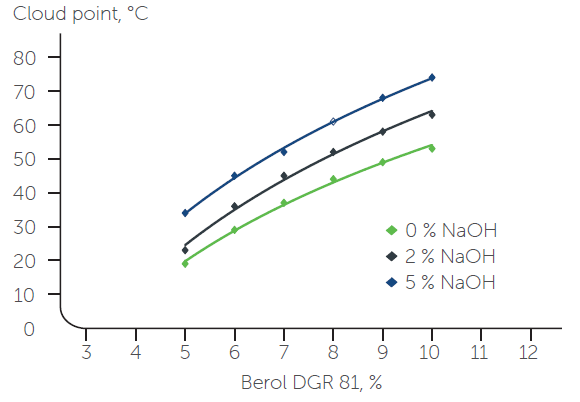Enhanced TDS
Identification & Functionality
- Chemical Family
- Cleaning Ingredients Functions
- Technologies
- Product Families
Features & Benefits
- Labeling Claims
- HII Features
- Product Highlights
- Degreasing, mineral oil vegetable fat and charred fat: In industrial cleaning, dirt usually contains mineral oil/grease and particles. To emulsify mineral oil the pH is not important, but to have good dispersing of the particles the pH should be ~11. When the oil/grease is charred and difficult to emulsify a high amount of caustic is necessary to boost performance. Berol DGR 81 work well in this situation.
- Pigment removal and dispersing: To remove particles and to keep them dispersed in the solution so they do not re-deposit onto the surface is important in all cleaning applications. For example in vehicle cleaning dirt contains a lot of particles, not only from the road but also from pollution from the air. These particles, “traffic film”, are extremely small and very difficult to remove in touchless/brushless machines, which have become more and more common today. Using highly alkaline cleaning formulations, enabled by using Berol DGR 81, helps lift such soils from vehicle surfaces, keeps them dispersed and enhances vehicle cleanliness.
Applications & Uses
- Markets
- Applications
- Home Care Applications
- I&I Cleaning Applications
Properties
- Physical Form
- Soluble in
- 5% Water
- Characteristics
Value Units Test Method / Conditions Active Content 95.0 % - Clear Point -15.0 °C - Flash Point min. 100 °C - Pour Point 0.0 °C - Specific Gravity 1.1 - - Viscosity (at 20°C) 1600 cPs - Viscosity (at 60°C) 169 cPs - Viscosity (at 70°C) 60 cPs - Viscosity (at 50°C) 222 cPs - Viscosity (at 40°C) 457 cPs - Viscosity (at 30°C) 1025 cPs - Viscosity (at 10°C) 10178 cPs - Viscosity (at 15°C) 3000 cPs - Viscosity (at 4.4°C) 10400 cPs - Surface Tension (at 25°C, 0.1% Solution) 27 mN/m Du Noüy (DIN 53914) Wetting Power (at 25°C, 0.1% Solution) 20 seconds Draves Wetting Test - Specifications
Value Units Test Method / Conditions Color 0 - 10 - Gardner pH 7.0 - 9.5 - - Water Content 4 - 6 % -
Regulatory & Compliance
Technical Details & Test Data
- Foaming Test Data
Foaming: In many applications low foam is required. Berol DGR 81 is an excellent degreaser with low to medium foam. In CIP (Cleaning in Place) it is not enough to have a low foaming product, it also has to be de-foaming. In breweries, dairies and machine dishwashing, highly alkaline cleaning products are used, and here it is important not only to clean but also to eliminate protein foam. In some applications foaming is important. Berol DGR 81 can, and should if possible, be used as the only surfactant, but it is compatible with all other types of surfactants, if for example more foam is desired.
Foam height Berol DGR 81

Foaming profile of Berol DGR 81 when tested in the circulation method. Albumin was used as foaming agent. The graph shows that Berol LFG 61 provides anti-foaming properties in this system.
- Cloud Point Test Data
The cloud point increases with increasing amount of product and/or increasing amount of NaOH. It is very similar for the two blends and follows the same trend. Increasing the amount of chelating agent in the formulation has a decreasing effect on the cloud point.
Cloud point Berol DGR 81 + NaOH

Graph: x% Product, 0, 2 and 5% NaOH, 10% Dissolvine GL-47-S and balance with demineralized water
Packaging & Availability
- Supplied by
